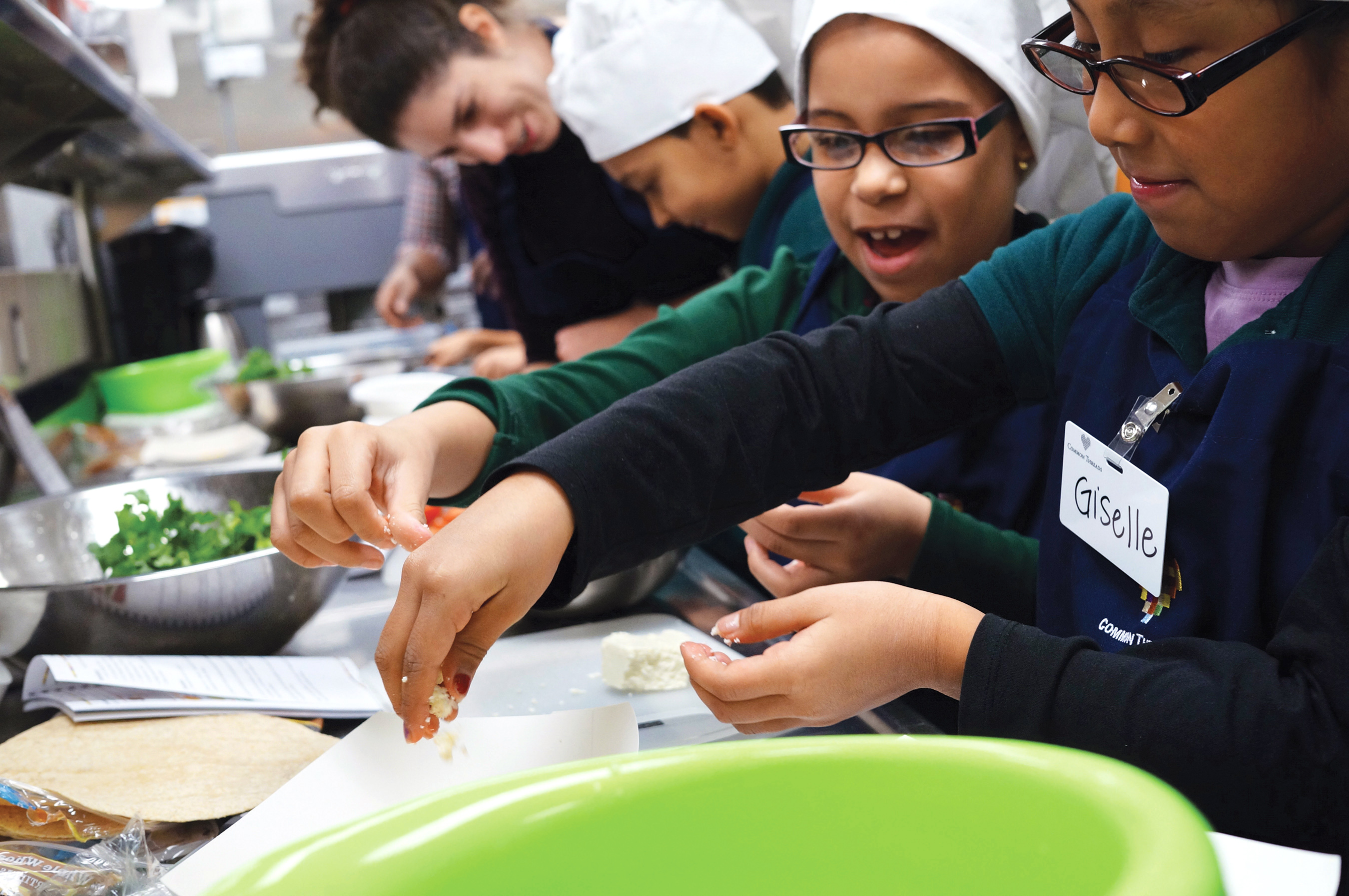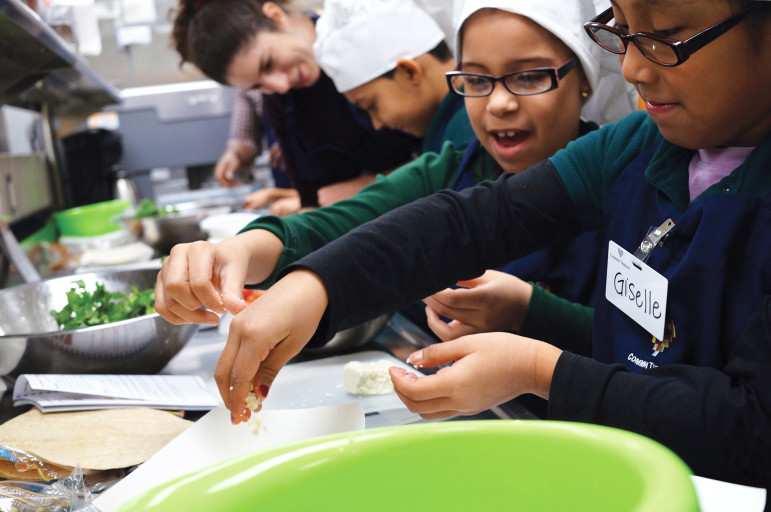
Photos by Meral Agish
Third graders Giselle Romero, 8, and Jelany Rodriguez, 8, crumble queso fresco, a traditional Mexican cheese, while classmates prepare other ingredients for the day’s chicken quesadillas. Students in the Common Threads program share responsibilities for all kitchen and clean-up duties.
NEW YORK — Every Tuesday afternoon, a school cafeteria in Brooklyn becomes a professional kitchen staffed by third- and fourth-graders. With the help of a new after-school program, these young chefs learn how to slice, dice and chop like pros as they make healthy meals to share together.
Common Threads, a Chicago-based nonprofit organization, recently expanded to New York City and launched its cooking program at Public School 89 in Cypress Hills, Brooklyn. The program takes a holistic approach to food education, emphasizing cultural understanding and cooking skills as much as nutritional values.
New York is the latest addition to Common Threads’ roster of programs in Chicago, Los Angeles, Miami and Washington, D.C., working with nearly 16,000 students last school year in 113 partner schools. The organization is planning to launch soon at a school in Harlem and hopes to expand to two other cities by the end of 2015.
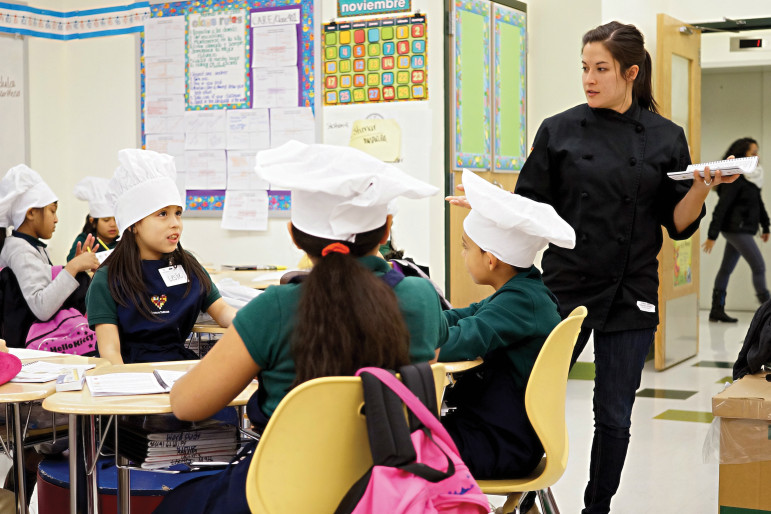
Before heading to the kitchen, Stephanie Folkens, Common Threads’ curriculum and quality assurance manager, leads the students in a discussion about Mexican cuisine and table etiquette. Each class begins with a lesson about the day’s recipe and country of origin.
“There’s so much attention on childhood obesity right now, and a lot of people are looking for resources that work,” said Stephanie Folkens, the organization’s curriculum and quality assurance manager. She hears more and more from school administrators that the students themselves are asking for cooking clubs and classes. “Our big goal is to get our kids cooking for life.”
Common Threads was founded in 2003 by artist Jesus Salgueiro and chef Art Smith, who had previously been Oprah Winfrey’s personal chef. The initial mission was to teach kids in low-income urban neighborhoods how to cook. Over time, the program developed its current health-oriented approach.
“Around 2012, we decided we wanted to offer a more holistic approach to cooking,” Folkens said. The curriculum, which now incorporates Common Core and Next Generation Science Standards, teaches nutrition and healthy eating habits during the course of a 10-week cooking and world cuisine program.
To help prepare the fledgling Brooklyn site, Folkens flew in from Chicago to oversee the day’s after-school program and coach Jerred Jones, the newly hired New York program manager. Dressed in a chef’s jacket and with her hair swept in a braid and ponytail, Folkens projected the professionalism that first brought her to Common Threads in 2010, when she began as a volunteer while still in culinary school.
After-school passports
The afternoon’s program, which would begin in a classroom and end in the kitchen, touched on Common Threads’ key values: good nutrition, respect for cultural diversity and appreciation of cooking and eating together. Folkens, Jones and two volunteers prepared for the looming arrival of 11 eager young chefs.
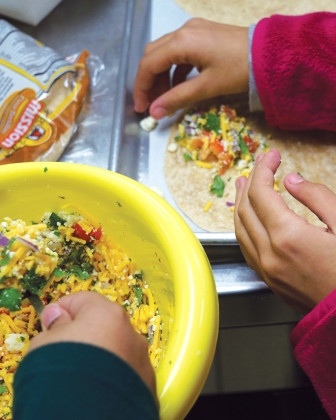
As soon as the ingredients are ready, students move on to the recipe’s next step. Here, fourth graders Liana Cabral, 9, and Amy Martinez, 9, scoop a mixture of cheese and salsa on each tortilla.
But before the kids could get cooking, they needed to get ready. In a quick transition between the end of the school day and the beginning of their after-school cooking class, the kids set up in a classroom, helping each other wrangle long apron strings and floppy chefs hats. They stood in groups of two and three, giggling at each other and saying, “You look good” with a hint of teasing. The adult-sized aprons skimmed their sneakers, and the hats slid down to their noses.
Once properly dressed, the young chefs sat at desks and opened their recipe guides, dubbed “passports,” to the day’s lesson: a trip to Mexico with a meal of chicken quesadillas and guacamole.
In a brisk 15-minute lesson, Folkens led the class through a discussion of ingredients, food groups and Mexican table etiquette. During a question-and-answer period about the colors of produce, she gently corrected a student who named cheese as a vegetable, then praised another’s properly accented pronunciation of cilantro.
Jones, the program manager, and volunteers floated around the room to check on the kids, crouching down by a desk whenever a student needed some one-on-one help going through the lesson or following the reading.
Cooking at home
With the classroom portion covered, it was time to cook. The group, noisy and excited, walked downstairs to the school’s kitchen. Surrounded by gleaming stainless-steel counters and orderly shelves of professional tools, the kids stood by a chef’s cart for a quick lesson in proper kitchen prep. An industrial mixer off to the side stood taller than a few of the kids.
Framed by the door of a walk-in refrigerator, Folkens demonstrated how a professional chef prepares a recipe. She had the students repeat words like mise-en-place and mirepoix, terms familiar to fans of the Food Network and “Top Chef” but less so for the elementary school set.
Her tone was friendly yet firm as she repeated instructions and demonstrated how to use tools that are far from traditionally kid-friendly. Her chef’s knife, with a sharp blade as long as a child’s forearm, was the same the kids would soon use to chop garlic and slice avocados.
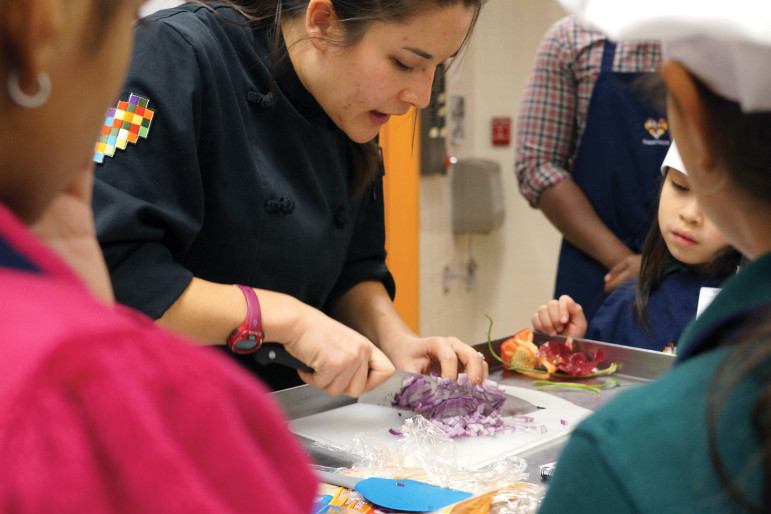
Folkens demonstrates the correct way to use a knife to protect fingers while dicing an onion. Before students are allowed to use knives, they receive instruction in proper techniques and are always under adult supervision.
Common Threads’ students use the same types of tools professional chefs use, which gets them acquainted with the knives, measuring cups and baking pans that may be in their own kitchens. After all, the goal, Folkens said, is to get kids cooking in their own homes.
But more important, especially with these young students, is learning how to use potentially scary tools safely. “It’s really important that the kids are using the appropriate tools for the right job,” Folkens said. A dull knife, for instance, may potentially be more dangerous than a sharp one since it requires more effort and pressure to do the same job.
The young chefs often have their own aversions and take extra precaution without having to be told. “Most of the time we find that kids are scared of different things in the kitchen. They themselves are already practicing safety,” Folkens said. That afternoon in Brooklyn, the kids cut carefully and slowly, and always with adult supervision. The program maintains a maximum grouping of five students to every adult, and a zero-tolerance policy for unsafe behavior. All knives are accounted for before class ends and are stored securely until the following class meeting.
While there were a few close calls with little fingers, the students handled their new tools with care. The only mishap involved a baking sheet that slipped into a sink, spilling a few scoops of cheese from the prepared quesadillas.
As for the recipes themselves, Common Threads works with registered dietitians to ensure the curriculum’s nutritional information is well-researched and accurate. The recipes rely on whole grains and fresh produce, with limited use of added salt, sugar and fats.
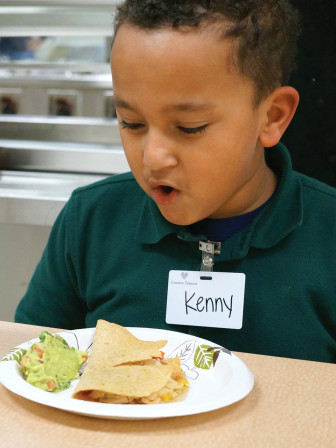
Third grader Kenny Perez, 8, sits down to eat the freshly baked quesadillas and guacamole. Even if time runs short, every session ends with a shared meal with classmates.
Common Threads’ chef instructors sometimes bring in science experiments to show students the differences between types of food. To investigate why whole grains keep you fuller longer than processed grains, kids drop pieces of white bread and whole grain bread into separate cups of vinegar that mimic the effects of stomach acid.
“It’s a visual example of how full grains keep their integrity,” Folkens said, while the white bread rapidly dissolves. “The kids love it because the bread gets all goopy.”
While the nutritional guidelines may seem to be far from the students’ minds as they worked in pairs or peered over classmates’ shoulders as they chopped and mashed, Folkens said Common Threads’ curriculum strives for permanent change of habits. They have aligned the program with research conducted by Dr. Isobel R. Contento of Columbia Teachers College that shows children need between 40 and 50 hours of nutrition education in order for healthy habits to stick. During the 10-week after-school program, students receive 20 hours of instructional time. The hope is that kids will bring what they learn home and help change their families’ own cooking and eating habits. As students move from one Common Threads sequence to the next, the expectation is they will accrue the target total hours to change their cooking and eating behavior for good.
With just about 15 minutes left in the day, in Brooklyn’s P.S. 89 school kitchen, it was finally time to eat. The serving team passed out plates with scoops of guacamole and quesadillas fresh out of the oven. Anyone who sniffed at the meal was told they had to try it with what Folkens called a “no thank you” bite.
Asked how the meal was, fourth-grader Henry Contreras, 9, took a bite and said, “Good. Better than I thought.”
Translated from the language of picky eaters, that sounded like a rave review.
Meral Agish is a freelance writer in Brooklyn.
Common Threads:
CommonThreads.org/
- Youth served: Last school year, the program served 15,700 students at 113 partner schools in five cities (Chicago, Miami, Los Angeles, San Francisco Bay Area, Washington).
- Annual budget: $2.4 million in 2013
- Major donors: In 2013 the Walmart Foundation donated more than $1 million. Other major donors include BMO Harris Bank, the Chicago Blackhawks Community Fund, the Educational Foundation of America and Hillshire Brands & the Hillshire Brands Foundation.
- Publications: Annual report
- Partnerships: All after-school programming is done in partnership with public and charter schools.
- Nutritional guidelines: Common Threads takes pride in its curricula’s use of fresh and unprocessed ingredients.
- Use whole grains, fresh fruits and vegetables, lean meats (organic whenever possible), hormone-free dairy, low-sodium versions of foods like canned beans and vegetable broths or bouillon, and less-processed fats and oils, like cold-pressed olive oil.
- Minimize use of refined sugar, butter and cream.
- Never use products that contain high-fructose corn syrup or hydrogenated oil.
- Choose healthy pre-class snacks (veggies, fruit, grains, etc.).
- Lessons to share: The organization emphasizes education that spans nutrition, cooking and context. The program is “not just teaching … recipes,” said manager Stephanie Folkens. Common Threads’ instructors apply this nutrition education expertise to engaging activities that get students involved in every step of the process, from preparing ingredients to cleaning work spaces to sitting and enjoying a meal together.


